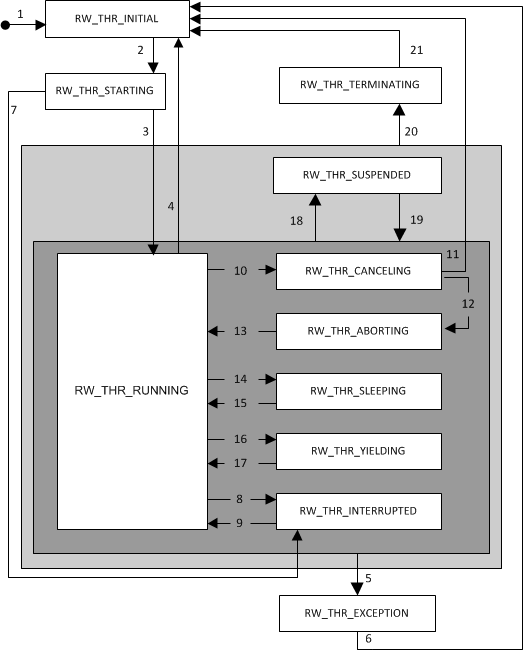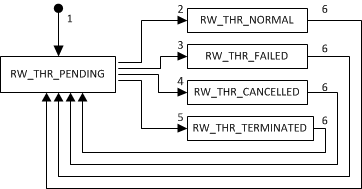Runnable State
Each runnable object maintains two pieces of state information: a current execution state, and a current completion state. The following paragraphs explain the various operations that the Threading package includes for manipulating runnable objects and their state.
NOTE: Many of these operations rely on or make changes to the execution or completion state of a runnable. To help you better understand these relationships, study the state diagrams in
Figure 7 and
Figure 8 and use them as a reference as you read.
The current execution state is represented by the enumerated type
RWExecutionState, which defines the following state values:
 RW_THR_INITIAL
RW_THR_INITIAL — The initial state is used to indicate when a runnable is
inactive. A runnable is created in the initial state and always returns to the initial state after it completes execution.
 RW_THR_STARTING
RW_THR_STARTING — A runnable temporarily enters the starting state after
start() is called and remains in that state until the runnable is ready to execute its internal
run() member.
 RW_THR_RUNNING
RW_THR_RUNNING — The runnable is
active and executing inside its
run() member.
 RW_THR_INTERRUPTED
RW_THR_INTERRUPTED — The runnable is active, but has been
interrupted, and is currently waiting to be
released from the interrupt.
 RW_THR_SUSPENDED
RW_THR_SUSPENDED — The threaded runnable is active, but its thread has been
suspended, and is waiting to be
resumed.
 RW_THR_CANCELING
RW_THR_CANCELING — The runnable is active, but is currently attempting
cancellation.
 RW_THR_ABORTING
RW_THR_ABORTING — The runnable is active and has
aborted an attempted cancellation.
 RW_THR_SLEEPING
RW_THR_SLEEPING — The runnable is active, but its thread is currently
sleeping.
 RW_THR_YIELDING
RW_THR_YIELDING — The runnable is active, but its thread is currently
yielding execution.
 RW_THR_SERVER_WAIT
RW_THR_SERVER_WAIT — The runnable server is active, but is currently waiting for another runnable to be enqueued for execution.
 RW_THR_EXCEPTION
RW_THR_EXCEPTION — The runnable is exiting because an exception was produced.
 RW_THR_TERMINATING
RW_THR_TERMINATING — The runnable is being
terminated by another thread.
Figure 7 demonstrates the various execution state transitions.
The current completion state is represented by the enumerated type
RWCompletionState, which defines the following state values:
 RW_THR_PENDING
RW_THR_PENDING: The runnable has not been started since it was created, or the runnable is currently active. The completion state is reset to
RW_THR_PENDING each time
start() is called.
 RW_THR_NORMAL
RW_THR_NORMAL: The runnable completed execution normally.
 RW_THR_FAILED
RW_THR_FAILED: The runnable exited with an exception.
 RW_THR_CANCELED
RW_THR_CANCELED: The runnable was canceled.
 RW_THR_TERMINATED
RW_THR_TERMINATED: The thread executing the runnable was terminated.
Figure 8 demonstrates the various completion state transitions.
In addition to the execution and completion states, each runnable also captures any exceptions produced during execution. Any of these exceptions can be recovered by requesting the runnable to rethrow the exception.









